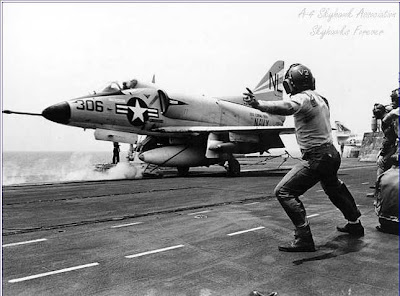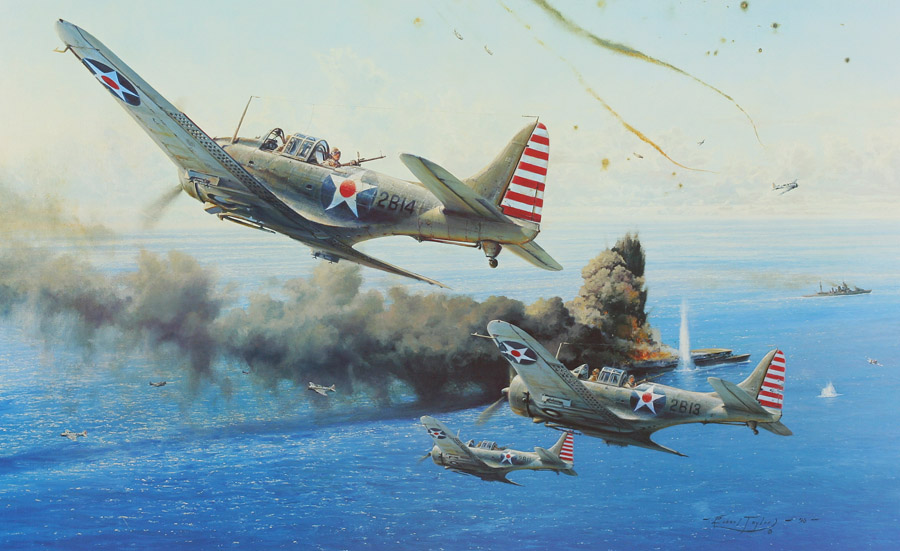Navy Aviator Missing In Action From the Vietnam War Identified

NEWS RELEASES from the United States Department of Defense
No. 104-07 IMMEDIATE RELEASE
January 29, 2007
He is Navy Cmdr. Peter Mongilardi Jr., of Haledon, N.J. He will be buried on April 11 at Arlington National Cemetery near Washington D.C.
On June 25, 1965, Mongilardi departed the USS Coral Sea in his A-4C Skyhawk on an armed reconnaissance mission over North Vietnam.His flight encountered bad weather and enemy fire over Thanh Hoa Province, causing the wingman to lose visual and radio contact with Mongilardi.Contact was never re-established and the aircraft failed to return to the carrier.
In 1993, a joint U.S.-Socialist Republic of Vietnam (S.R.V.) archival team, led by the Joint POW/MIA Accounting Command (JPAC), obtained information concerning the crash while researching documents, artifacts and photographs at the Central Army Museum in Hanoi.Later that year, another joint U.S./S.R.V. team conducted an investigation in Thanh Hoa Province.The team interviewed two local Vietnamese citizens who recalled the crash and said the pilot died in the impact.The men then led the team to the crash site.
In 1994, another joint team excavated the crash site and recovered human remains and pilot-related items, including a belt tip, boot heel, pieces of flight boot and other items worn by the pilot.
Among other forensic identification tools and circumstantial evidence, scientists from JPAC and the Armed Forces DNA Identification Laboratory also used nuclear DNA in the identification of the remains.
The Rest of The Story…
VA-153 Log Entry:
The Action:
 Synopsis: Air Wing 15 deployed to Southeast Asia in November 1964 onboard the aircraft carrier USS CORAL SEA, participating in FLAMING DART’s two raids in retaliation to North Vietnamese aggression in the Gulf of Tonkin. One of the attack squadrons in Air Wing 15 was the Blue Tails – Attack Squadron 153, so named because of the splash of blue on the tails of their A4 Skyhawks. CDR Peter Mongilardi Jr. was the skipper of VA 153 until May 1965, at which time he assumed duties as air wing commander (CAG), and was replaced by CDR Harry E. Thomas. Before the long cruise was over in December, both Mongilardi and Thomas were dead. < ?xml:namespace prefix = o />
Synopsis: Air Wing 15 deployed to Southeast Asia in November 1964 onboard the aircraft carrier USS CORAL SEA, participating in FLAMING DART’s two raids in retaliation to North Vietnamese aggression in the Gulf of Tonkin. One of the attack squadrons in Air Wing 15 was the Blue Tails – Attack Squadron 153, so named because of the splash of blue on the tails of their A4 Skyhawks. CDR Peter Mongilardi Jr. was the skipper of VA 153 until May 1965, at which time he assumed duties as air wing commander (CAG), and was replaced by CDR Harry E. Thomas. Before the long cruise was over in December, both Mongilardi and Thomas were dead. < ?xml:namespace prefix = o />
It was during this period that the North Vietnamese, assisted by the Soviet Union and Chinese, was beginning to build its military from technology-poor and ground-oriented military to one with one of the world’s strongest and most sophisticated air defense networks.
As a defense against U.S. air strikes over North Vietnam (ROLLING THUNDER) North Vietnamese missile sites grew from ground zero in 1965 to estimates three years later of two hundred surface-to-air (SAM) sites nationwide and some thirty missile battalions in the Hanoi area alone. Each battalion contained up to six missile launchers plus accompanying radar, computers and generators. The U.S. discovered the first SAM site in April 1965, yet U.S. pilots were forbidden to take immediate defensive action.
The CORAL SEA was in Japan in June 1965 on its way to the U.S. The ordnance and aircraft had already been offloaded, and Thomas and Mongilardi were on a last liberty together. While on liberty, they discovered they were shipping back to Vietnam.
On the first day back, Mongilardi and his wingman, Paul Reyes, flew on an armed reconnaissance mission. CDR David Leue and his wingman were briefed at the same time in case one of the wingmen went down, and, as luck would have it, Leue’s wingman could not transfer his drop tank and was sent back to the ship. Leue joined up with Pete and his wingman. Leue describes armed “recce” as “usually two people flying down a route, really target practice for the local AAA batteries as you come down the pike. I always said if I made it to admiral I would not have done traditional armed recce. To(o) many people are lost.”
The three pilots were in the area of Thanh Hoa. Leue was flying with instrument problems, and had no air speed altimeter or pressurization. It was no problem except for determining the flight altitude. Through some broken clouds, Leue spotted a power plant below and radioed that he was rolling in on it. Mongilardi ordered him not to hit the plant because it was denied under the rules of engagement.
By this time, Leue had pulled away from Mongilardi and his wingman, and he turned to rejoin them. As he did, Mongilardi radioed, “I’m rolling in on a little bridge,” followed by, “Flak.” Leue heard Mongilardi get hit and said, “He actually keyed the mike, I heard a couple of deep breaths, and I called Reyes to ask ‘Where are you?’ Paul said, ‘We’re by this rain storm and I’ve lost CAG [Mongilardi]. I don’t know where he is.’ Well, he’d been shot and killed; a real tough loss.”
Leue was saddened to lose Mongilardi, whom he described as “a superior air wing commander, naval officer and warrior.” It was less than two months later, on August 13, 1965, when CDR Harry Thomas was shot down 70 miles west of Hanoi on a low-level strike mission searching for SAM sites. Thomas’ aircraft flew into a volley of flak, was hit and crashed. Thomas did not survive. Leue was moved into the position of skipper of the Blue Tails, carrying with him the sadness of having lost two superior squadron commanders.
CDR Mongilardi was originally classified Killed in Action, Body Not Recovered. He was listed among the missing because his remains not found at the time.
(Source: http://www.pownetwork.org/bios/m/m431.htm)
The Recovery:
Peter Mongilardi’s last known location was approximately 13 miles (22 kilometers) northwest of Thanh Hoa, 3 miles (9 kilometers) northeast of Kien Trung, ½ mile (1 kilometer) south of Mao Ax and 24 miles west of the coastline, Dong Son District, Thanh Hoa Province, North Vietnam. The two remaining flight members initiated an immediate search for their flight leader over a heavily populated open flat area crisscrossed with numerous creeks, rivers and rice fields. They saw no parachute either in the air or on the ground and heard no beeper signal.
Over the next 2 to 3 days an extensive search and rescue (SAR) effort was conducted over the original search area and then extended to include the jungle covered mountains to the north and west of the target area. Air assets used in this massive operation included 15 – A1H’s, 10 – F8’s, 3 – A3D’s and 2 – F4’s.
Because of the last known heading of Cmdr. Mongilardi’s Skyhawk, 70% of the entire SAR area consisted of dense jungle growth and only 30% over the area inundated with water. At the time formal search efforts were terminated, Peter Mongilardi, Jr. was listed Missing in Action. On 19 July 1965, conclusive evidence of death was received and on 23 July Cmdr. Mongilardi’s status was changed to Killed in Action/Body Not Recovered. What that conclusive evidence was comprised of is unknown.
During the July 1985 technical meeting between US and Vietnamese personnel discussing the fate of American POW/MIAs, Mr. Cu Dinh Ba, Chief of the Vietnamese Office Seeking Missing Persons, stated his office’s personnel had investigated this incident. During the investigation, local residents recalled the crash of an A4C on 25 June 1965. (N)o remains were available to inter…no identification media was found in or near the Skyhawk’s wreckage.
In June 1993, Mr. Ba’s report was passed to the Vietnamese government in a briefing folder along with other relevant documents during a meeting in DaNang because the Office for Seeking Missing Persons was going to assist in the joint recovery effort of this crash site. Shortly thereafter a site survey was conducted to evaluate the feasibility for excavating the area in the hope of recovering Peter Mongilardi’s remains.
In October 1994, a joint American/Vietnamese team under the auspices of the Joint Task Force for Full Accounting (JTFFA) fully excavated this crash site. They found and recovered pieces of aircraft wreckage, pilot related items, life support equipment and 4 bone fragments – the largest of these bone fragments is less then 2½ inches long. The 4 bones are “consistent with being human,” but cannot be confirmed to be human. If human, they are believed to be from the long bones of either the arms or legs.
Because they are so small, mtDNA technology is not advanced enough to be used in the identification process. The hope is that technical advances in the future will yield the ability to identify these bone fragments and determine conclusively if they constitute the only recoverable mortal remains of Cmdr. Mongilardi. (ed: Obviously with today’s announcement that hope has come to pass)
(Source: http://www.taskforceomegainc.org/m431.htm)
A significant codicil to the recovery effort were the unceasing actions of CDR Mongilardi’s family in striving to bring him home, particularly of his son and daughter.
Welcome home CAG…rest easy now that your journey is complete.
The Skyhawk Association (Source of picture of NL 306)
New Jersey Vietnam Veterans Memorial


